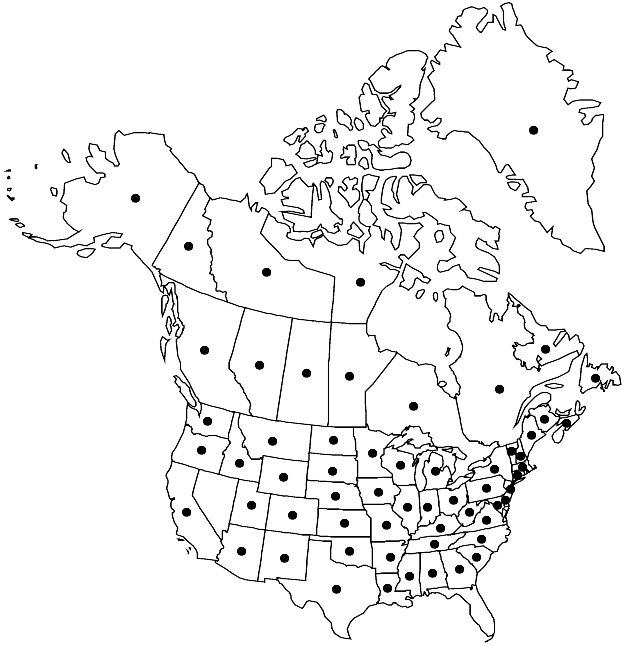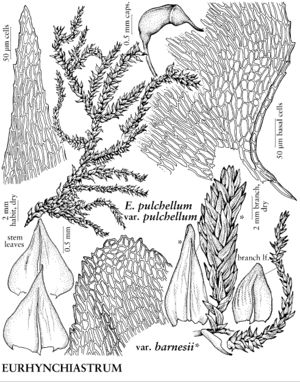Difference between revisions of "Eurhynchiastrum pulchellum"
Arctoa 11: 262. 2003.
FNA>Volume Importer |
imported>Volume Importer |
||
| Line 65: | Line 65: | ||
|publication year=2003 | |publication year=2003 | ||
|special status=Illustrated | |special status=Illustrated | ||
| − | |source xml=https:// | + | |source xml=https://bibilujan@bitbucket.org/aafc-mbb/fna-data-curation.git/src/bb6b7e3a7de7d3b7888a1ad48c7fd8f5c722d8d6/coarse_grained_fna_xml/V28/V28_680.xml |
|genus=Eurhynchiastrum | |genus=Eurhynchiastrum | ||
|species=Eurhynchiastrum pulchellum | |species=Eurhynchiastrum pulchellum | ||
Revision as of 22:48, 27 May 2020
Plants glossy. Stems 2–6(–13) cm, branches 3–8(–17) mm. Stem leaves broadest at 1/10 leaf length or below, 0.5–1.3(–2.6) × 0.4–0.9(–1.8) mm; base rounded to insertion; margins plane or recurved proximally; alar cells 12–20 × 10–15 µm, region subquadrate, small, ± distinct, often surrounded by subquadrate cells in ± extensive, indistinctly delimited group; laminal cells 30–75(–100) × 4–6 µm, smooth; basal juxtacostal cells 7–10 µm wide. Branch leaves 0.2–1.3(–1.9) × 0.2–0.5(–1) mm; costa to 60–90% leaf length; laminal cells just before apex short, nearly isodiametric or irregular in shape. Seta 1–1.8 cm. Capsule 1.5 mm. Spores slightly papillose.
Distribution

North America, Mexico, Central America, Eurasia, n, e Africa, Atlantic Islands, Pacific Islands.
Discussion
Varieties 2 (2 in the flora).
Eurhynchiastrum pulchellum is easy to recognize by its blunt branch leaves. The common phenotype for plants on soil and tree trunk bases in forests is light green plants with rigid erect leaves. In xeric and arctic environments, leaves are strongly appressed forming julaceous shoots, and plants are often brownish and quite fragile. They have been segregated as var. praecox (temperate areas, branch leaves 0.5–0.8 mm, alar cells as in typical variety) and var. diversifolium (arctic-alpine, branch leaves 0.5–0.6 mm, alar cells very numerous) but these grade to typical phenotypes and thus do not merit taxonomic recognition. Some collections described as Eurhynchium strigosum var. scabrisetum Grout have roughened setae, although the mammillae are very low, appearing as a shallowly wavy outline mostly at mid seta. In various parts of North America, plants of more robust stature occur. They were described at the level of variety (var. barnesii, var. robusta), of even species (Eurhynchium fallax, E. substrigosum, E. tayloriae). Plants with broadly triangular branch leaves up to 1 mm have been reported from California and Colorado as Eurhynchium striatum (D. H. Norris and J. R. Shevock 2004; W. A. Weber and R. C. Wittmann 2007). Among the taxa of large Eurhynchium pulchellum, H. A. Crum et al. (1965) accepted only var. barnesii, as the largest one in all dimensions, and this treatment is followed here.
Selected References
None.
Key
| 1 | Stem leaves 0.5-1.3 mm; branch leaves 0.2-1.1 × 0.2-0.5(-0.6) mm, not or slightly plicate. | Eurhynchiastrum pulchellum var. pulchellum |
| 1 | Stem leaves 1.2-2.6 mm; branch leaves 1-1.9 × 0.4-0.8(-1) mm, strongly plicate. | Eurhynchiastrum pulchellum var. barnesii |
